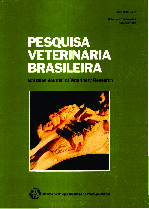 |
|
|
|
Year 1997 - Volume 17, Number 2
|

|
Sensitivity and specificity of the Califomia Mastitis Test as a diagnostic tool for subclinical mastitis in quarter somatic cell count estimation, 17(2):49-53
|
ABSTRACT.- Brito J.R.F., Caldeira G.A.V., Verneque R.S. & Brito M.A.V.P. 1997. [Sensitivity and specificity of the Califomia Mastitis Test as a diagnostic tool for subclinical mastitis in quarter somatic cell count estimation.] Sensibilidade e especificidade do "California Mastitis Test" como recurso diagnóstico da mastite subclínica em relação à contagem de células somáticas. Pesquisa Veterinária Brasileira 17(2):49-53. Embrapa - Centro Nacional de Pesquisa de Gado de Leite, Rodovia MG 133, km 42, Coronel Pacheco, MG 36155-000, Brazil.
The California Mastitis Test (CMT) is a simple and widely used diagnostic tool for subclinical mastitis. lt is used even in areas where laboratory facilities are available for diagnosis and monitoring program purposes. CMT usually score 1-5, where 1 indicates a completely negative reaction and 2-5 increasing degrees of inflammatory reaction of the udder. The reactions 2-5, 3-5 or 4-5 may be considered as indicative of subclinical mastitis, because they are related to an increase of the somatic cell count (SCC) in the milk. This variation, however, may produce either false-positive or false-negative results. The aim of this study was to assess the sensitivity and specificity of the CMT in comparison with SCC. A total of 3,012 quarter milk samples from 760 lactating cows were examined. CMT was evaluated at the moment of sampling at cow side and SCC in the laboratory, with a fluoro-opto-electronic method (Fossomatic 90). The average CCS (x 1,000 cells/ml) for CMT scores were: 1 (79.9), 2 (333.5), 3 (670.3), 4 (1,354.0) and 5 (4,455.6). Three options for CMT interpretation were evaluated in relation to a range of CCS, starting from 100,000 cells/ml: (a) 1 versus 2, 3, 4, and 5; (b) 1 and 2 versus 3, 4 and 5; and (e) 1, 2 and 3 versus 4 and 5. The sensitivities of CMT scoring to detect quarters with SCC >200,000/ml were 79%, 61% e 34%for options a, b ande, respectively. The sensitivities of CMT scores for SCC >500,000/ml for options a, b ande, were, respectively, 93%, 82% e 54%. The sensitivity of CMT scores to identify subclinical mastitis was satisfactory (above 80%) when options b ande were used. The interpretation of CMT score 3 as negative for subclinical mastitis was considered as adequate (sensitivity around 80%) only when CCS ranged between 1,200,000 and 1,400,000 cells/ml. The specificities of CMT scoring for CCS of 200,000 and 500,000 were, respectively, 90% and 80% (option a), 97% and 90% (option b) and 99% and 97% (option e). |
| |
|
|
| |
|
 |